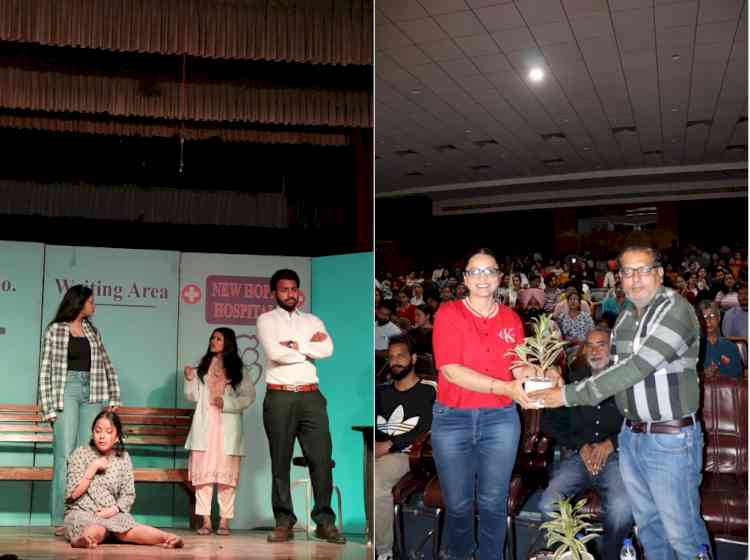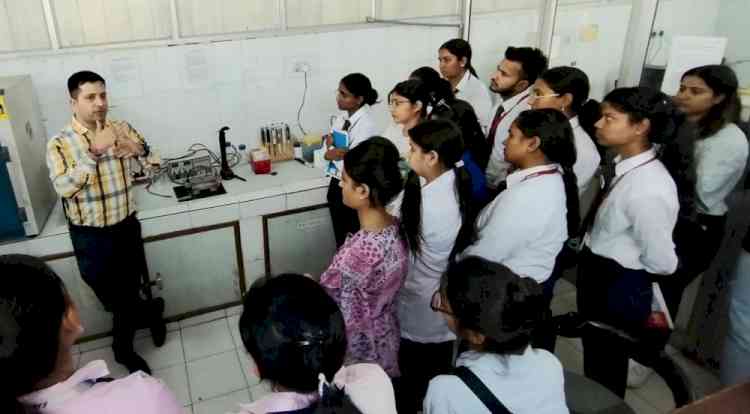CONCERNS OF THE EXPORTS SECTOR IN THE GST REGIME - PUT FORWARD BY FIEO IN MEETING OF EMPOWERED COMMITTEE OF STATE FINANCE MINISTERS ON GST
Author(s): City Air NewsNew Delhi, August 30, 2016: The Constitution (122nd Amendment) Bill, 2014 has paved the way for introduction of GST in the country. All agencies are gearing up to roll out the GST, the biggest indirect tax reform...

New Delhi, August 30, 2016: The Constitution (122nd Amendment) Bill, 2014 has paved the way for introduction of GST in the country. All agencies are gearing up to roll out the GST, the biggest indirect tax reform in the country, from 1st of April,2017. The GST will be a game changer for Indian economy and expected to increase the GDP growth by about 1-1.5% per annum. It will make India a single market and will facilitate movement of goods across States seamlessly.
The subsuming of major Central and State taxes in GST, complete and comprehensive set-off of input goods and services and phasing out of Central Sales Tax (CST) would reduce the cost of locally manufactured goods and services. This will increase the competitiveness of Indian goods and services in the international market and give boost to Indian exports. The uniformity in tax rates and procedures across the country will also go a long way in reducing the compliance cost.
GST is also likely to reduce the logistics cost in India which is one of the highest in the world. The multiple-point warehousing by manufacturers to save on CST will be eliminated. With GST on the anvil, manufacturers can set up warehouses for distribution at select strategic location without looking at the same tax planning options resulting in reduced cost of operations.
Export sector is worried with the implication of GST on exports. We would like to list the following issues for the kind consideration of the GST Council so that the facilities currently availed by the sector continues as exports sector faces competition with countries where the transaction cost is much lower. The challenging global scenario requires efficiency , cost cutting, inventory management and optimum utilization of capital particularly as a very significant part of exports is contributed by MSME sector .
Clarity on Zero Rating of Exports: We know that Government is committed to zero rating of exports and the same has been adequately clarified in Section (2) Sub-Section (109) of the Model GST Law. This makes it clear that on exports of goods & services, no tax will be payable but credit of the input tax relating to those exports shall be admissible. However, there is little confusion as Section 38 of the Model GST Law refers to refund of taxes on goods & services exported out of India. We require a clarification that the refund facility will be optional for the exporters on the same lines as exists under the Central Excise Act where the exporter has the option to clear the exports goods without payment of taxes or takes a refund of the duty paid by him. Those exporters who want exemption from GST on supply of goods /services for exports will be entitled for the same. A reiteration of the same will remove the ambiguity in the matter.
It may be mentioned here that section 38 Subsection 4(A) allows provision refund of 80% which may be increased to 90% as allowed presently for VAT in few States. Secondly, this 90% may be refunded within 10 days and the balance 10% within 30 days.
Further, Provisio to section 38(3)(b) of the GST Act requires the exporter to file a certificate that the incidence of the tax claimed as refund has not been passed on by him to any person. In case of exports the prices are determined by the competition in the international market and there could be cases where the exporter, in order to stay relevant and continue in business, has to execute orders below the costwhich could be construed as passing on the tax refund to the buyer. Hence the said certification should not be made applicable where refund is for input taxes for exports.
Exemption from IGST/CGST/SGST on imported /domestic inputs used in exports: For the input used in the goods/services which are exported, the exporters would be eligible for refund of unutilized input tax credit. With a view to ensure quick refund, 80% of the refund on account of exports of goods & services will be given expeditiously ,on provisional basis, while balance 20% will be refunded after due verification of documents. For the exporters , the facility of duty free imports/ procurement of inputs for exports should continue else it will lead to increasing requirement of working capital even for payment of IGST /CGST/SGST . This will hit MSME as their cost of capital is quite high, blunting their competitive edge in exports .The exemption will not lead to any loss of revenue as in any case exporters will be entitled to refund which affect their liquidity.
Exemption for Merchant Exporters: Merchant exporters were availing exemption from CST against Form-H but since GST would be dispensing with such paper requirement, we have to devise some other mechanism to provide exemption to merchant exporters. GST Council should explore the possibility of providing some separate code in the invoice for such supplies for exports which may be square off when the proof of exports is supplied online to GSTN. Merchant exporters are instrumental in a large chunk of country’s exports and the facility enjoyed by them should continue under the GST. Merchant exporter should not be required to pay tax and claim refund.
Exemption for Export Oriented Units: EOU Units may be provided exemption from IGST on their imports while supply from DTA to EOU needs to be treated as Zero rated supply. The CST refund facility presently available to EOUs will vanish under GST thereby eroding this advantage.
Legislative Changes for SEZ Scheme : Suitable legislative changes may be required in the SEZ Act to provide exemption from IGST, CGST, SGST on imports as well as domestic procurement of inputs. Section 26 and Section 30 of the SEZ Act would require appropriate modification to give effect to the same. Since supply from DTA to SEZ is treated as exports, it is to be ensured that zero rebating is available on such supplies. The definition of exports in the Model GST Law is at variance with SEZ Act . We need to synchronize the two to avoid any dispute.
10.Changes in Deemed Exports : GST would also require suitable changes in many of the Schemes in the Foreign Trade Policy .The categories of the deemed exports would be notified by the Government on the recommendation of the GST Council. However, deemed exports is vital to provide a level playing field to the domestic manufacturers supplementing "Make in India” and thus zero rating of such supplies would be a preferred option particularly for those supplies which are exempted from Customs Duty and IGST on their imports.
11.Capital goods/ Inputs for export production under instruments: Imports of duty free capital goods and inputs under EPCG and Advance Authorization will be subject to IGST under the Model GST Law. However, since such goods are primarily for export purposes with AU condition , GST council should consider to provide exemption from IGST on their imports so that working capital of exporters are not blocked in payment of IGST. The instrument for domestic procurement for exports like ARO/Inland Letter of Credit/Advance Intermediate Authorization also needs to be given similar treatment to provide a level playing field to domestic manufacturers.
12. Drawback Rates: Many of the small exporters particularly in handicraft, carpets, handlooms have represented that since they procure the goods from the unorganized sector, the duty paying documents of input tax credit would not be available with them. To address their concern , GST council should recommend to provide duty drawback at two rates : when input tax credit is availed (which will factor only the basic customs duty on imports) and when input tax credit is not availed (which will factor both basic customs duty and input tax credit) on the same lines as available currently in the Drawback Schedule for the CENVAT
13. Utilization of scrips : The utilization of the scrips issued to exporters is also an intricate matter. The MEIS/SEIS scrips will only be eligible for payment of basic customs duty as against their current utilization for payment of basic/additional /excise /service tax , which will hurt the exporters as usability of scrip will be restricted. Government should consider their utilization against CGST and SGST.
14. Supply of Scrips: Since sale of scrips are exempted from VAT in few States and subject to 4% VAT in few other States, GST council may keep them under Section 4(v) of Schedule IV of Model GST Law like other financial instrument.
15. Quick Refund through integration: To me the success of GST depends on quick refund of taxes paid by the exporters. We have to work in developing a platform which provides instant refund at the time of exports only by integrating GSTN and ICEGATE so that details of exports are captured on real time basis to ensure such refunds.
16. Definition of India: The definition of India for the purpose of IGST is 200 NM and whereas for the purpose of Customs Act is 12 NM plus specified structures up to 200 NM. This can create aberrations. For example High Sea sales between 12 NM and 200 NM may be taxed twice to IGST - once as a supply and later at the time of import. There is also lack of clarity in Model GST law on manner of taxation of supplies terminating/originating in territorial waters and in Continental Shelf (CS) & Exclusive Economic Zone(EEZ) beyond 12 NM. As per definition of interstate and intra state sales given in IGST Act, these would fall in neither of the two categories.
17. Addition in supplies as Exports: Currently, Section 5(1) of CST Act explains the concept of sale in the course of exports of the goods out of the territory of India In terms of amended Article 286,(through 101st Constitutional Amendment) Parliament will need to either amend the said Section 5(1) or frame a new legislation to explain the concept of supply in the course of exports of the goods or services or both out of the territory of India. While doing so, under amended Article 286(2), the following supplies need to be treated as exports:
Supplies from Indian territory to SEZ and any export oriented unit as prescribed under FTP
Supplies to Notified Deemed Export Project, including to Authorisation holder
Supplies by Supporting Supplier(s)
18. TAX on Advance Payment: Tax will be required to be paid even on advance payment received for a future sale of goods. Currently, this provision is there only in service tax and there is no provision to pay tax on advance received in respect of an agreement to sell. However, in the proposed GST regime, the same provision will also apply to goods as well which could create lot of problems in cases where the order is cancelled or amended.
19. Reverse Charge Mechanism (RCM): Currently RCM is applicable only for receipt of certain services. Under model GST Provisions (Section 72), RCM shall be applicable both for receiving goods and/ or services. RCM involves complications for assesse and hence alternative simpler mechanism should be developed and RCM should be done away in GST regime
20. In the Model GST Law, the buyer has to check the validity of the registration of the supplier and see whether the supplier has not been blacklisted by the Department. If the buyer has purchased / availed the services and he is unaware of the fact that Seller is blacklisted, the buyer will come to know only when he will upload the transaction of purchase in the next month while filing the return. To protect interests of the buyer, he should be able to check supplier’s status at the time of payment and should not be held responsible for the default caused between the period of payment and reconciliation.
21. Job Work: As per Proviso in Schedule 1 the “supply to job worker is not treated as supply of goods” and hence not subject to levy of GST. However the issues pertaining to return of goods from job worker to Principal’s unit should be simplified in line with the procedure as per Excise notification 214/86. Further, the supply from job worker back to the Principal unit even ‘if not a completed product’ should also not be treated as supply of goods and GST should not be levied. However materials if any that of job worker is used by him in execution of the job work should be subject to GST levy by raising a separate invoice. In case the job worker is not having input services or opting not to claim credit for input service, should be exempt from GST levy where the principal undertakes to pay the tax at the time of his supply of final product.
22. Exemption from GST for Foreign Agency Commission: Foreign agents play an important role in getting export orders. Their services are utilised by majority of the exporters and they charge commission which is mentioned in the shipping bills. They are paid as and when the export price realised. They have their offices located abroad and their services are rendered outside India.
Under Service Tax Act, Foreign agency commission is exempted from levy of service tax by way of Rule 9( c) of Place of Provision of Service Rules, where in case of intermediary services (including foreign agents) the place of service is location of service provider.
Under GST which is consumption based levy it may be subject to tax. Hence specific exemption for commission paid to foreign agents be given.
23. REBATE: Since the entire GST is system driven provision be made allowing exporter conversion of CGST credit and SGST credit not utilised/ to be utilised for intra state supply to IGST. The transfer be done by means of a contra document for the transfer tax amount and corresponding value, wherein the exporter will be both the supplier and receiver. The IGST credit ledger be debited to the extent of IGST payable on value of exports. The debit will be only to the extent of credit available and cannot exceed the credit available.
This debit amount be refunded in cash to the exporter, for which the exporter has to submit only the proof of exports to the proper officer under IGST or provide the details of exports and the same can be verified online from Customs data. This will obviate the necessary of filing multiple applications, documents and additional man power with the departments and the exporter.
The credit transferred from SGST and CGST can be recovered from respective Governments. Any wrong refund of taxes or refund in excess of credit available, be recovered as provided in the GST Act.
24. Insertion of Explanation under Notifications: As per Section 10 (3), for the purpose of clarifying the scope or applicability of any notification, an explanation may be inserted within one year of issuance of the notification, which will have effect as if it had always been part of the said notification.
The power to insert an Explanation within one year of issuance of a Notification, which would apply ab initio, runs counter to the law declared by the Supreme Court in Union of India vs. Martin Lottery Agencies Ltd. [2009 (14) S.T.R. 593 (S.C.)] and SEDCO Forex International Drill Inc. vs. Commissioner of Income Tax [(2005) 12 SCC 717], which is to the effect that an Explanation does not automatically take effect retrospectively even if it is stated to be “for the removal of doubts”. Hence, Section 10 (3) may kindly be withdrawn.
25. Transition Period:
In order that the exporters do not loose the Drawback where the goods had been exported under existing law, it is proposed at allow exporters to claim Drawback for shipments made during first 2 or 3 months from the appointed date and the refund made by way of Claim as existing procedures from Customs or CGST/ IGST authorities. The exporter will not be allowed to take input credit of taxes on materials lying in stock, WIP or finished goods on appointed date. However input credit of GST paid on purchases post GST be allowed.
Further where pending refund claims to be disposed of under earlier law “Provided that where any claim for refund is fully or partially rejected, the amount so rejected shall lapse.”In the case of exporters, refund claims have been filed after debiting the claim amount in eligible CENVAT credit lying in balance. Refund claim is filed to liquidate the CENVAT credit in to cash under Rule 18 of Central Excise Rules. In existing law if refund is rejected, the exporter is allowed to take back the CENVAT because the nature of CENVAT was eligible and then is at liberty to use this credit for Domestic sales.
The same Provision is required in the new GST law as well. There are a number of disputes currently under litigation for denial of such input credits. This is a legitimate Credit available to the exporter and he only debited it to avail of the export duty pass through and rejections on technical grounds are common place. The basic credit itself is not questioned. Not allowing exporters to take credit in case they lose their pleas is amounting to a huge Burden on exporters which is totally unwarranted

 cityairnews
cityairnews 
















